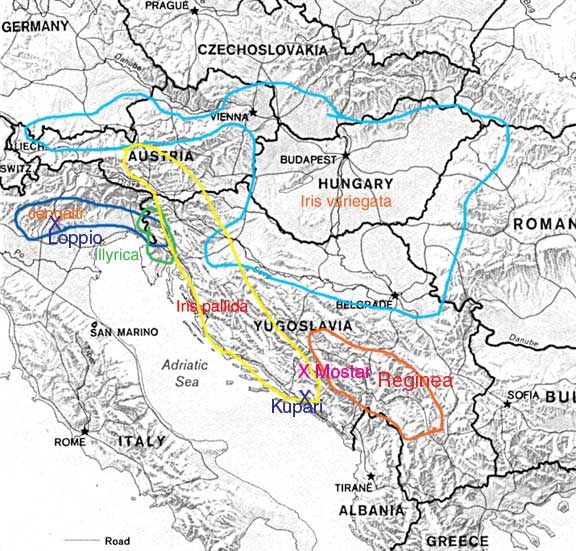This is a public-interest archive. Personal data is pseudonymized and retained under
GDPR Article 89.
RE: pallida and variegata distribution
- To: i*@yahoogroups.com
- Subject: [iris-species] RE: pallida and variegata distribution
- From: i*@netscape.net
- Date: Sat, 02 Apr 2005 07:16:35 -0500
Here is a map of the distribution of Iris pallida and Iris variegata, drawn up as well as I could based on information in a number of sources. The distribution of pallida throughout southern France and throughout central Italy has always been considered a byproduct of the orris root/perfume trade and not representing natural wild distribution. A lot of place names have different spellings than originally listed and this took some searching. Lake Loppio no longer exists. It was accidentally drained in 1956 after construction of some flood controls. It is now called Loppio swamp, and not placed on any large maps.
Pallida, cengialti and Illyrica are all found in hilly mountainous areas. Cengialti is named for Mt. Cengialti near Largo di Gardo in northern Italy. Were it was found, it had been described as growing in masses, hanging onto relatively steep slopes of the mountains.
Illyrica is located on Illyrica peninsula in a limited location, where pallida and cengialti distributions overlap. There is a protected nature area near Largo di Gardo which includes Mount Cengialti and Mount Brione, two locations were cengialti have been extensively collected. In a biological survey of this nature reserve there were also found I. germanica form I. benacensis, I. sambucina and I. squalens. The last two are considered natural hybrids of pallida and variegata. Sambucina is violet or bluish self. I. benacensis was classified as a name for I. aphylla by Dykes, based on observation of herbaceum specimens and would seem to be dark purple. Others have felt it is a form of germanica based on a closer look and chromosome count, which I haven’t located as of yet.
Pallida is located from southern Tirol region of Austria through east Adriatic sea to “as far south as Kotorâ€. As it turns out Kupari is a very small sea port only a few miles west of Kotor , which is the closest city big enough to get on the map. The pallida seen just 8 km north of Kupari were described as being seen in masses on the cliff sides, growing down to the sea coast, in many varied shades. The mid sections of the east side of the Adriatic Sea is referred to as the Dalmatia coast and at times this included the north section. This area was controlled by the Venetians for a period of time and at least during Marco Polo’s time (1250-1300). It’s easy to how the pallida from this area got to Italy.
Iris variegata is found in open woodlands. I posted where I had records of it occurring and was collected. Its area of distribution was based on topological maps based on it’s plant habits in that all locations it was reported from were quite free of hilly regions as seen in known locations.
Reginea was difficult to pin point , but it was reported in Macedonia and Yugoslavia. These regions are more hilly then typical region of variegata and more like areas were pallida were found. Reginea and pallida seem to overlap at the south end of pallida’s range. Based on its location and plant growth it should have also been in Albania ( between reported locations of Yugoslavia and Macedonia ) but I can’t locate any reports of it being collected or observed there. Where it was seen it was reported as being in small scattered pockets and located over a wide area.
Variegata and pallida were reported to overlap in Tirol region and in Eastern range of mountains along Adriatic coast. Topological maps gave some possible areas.
Cengialti and the Tirol area of pallida distribution are separated by a short distance but by an imposing natural barrier of the southern Alps. I didn’t see any low passes through the Alps in these regions but perhaps a more detailed and smaller ratio map would show some.
The glaciata pallida , Kupari was at the most southern area of pallida distribution according to the information I found.
A very interesting exercise. I’m sure there are some inaccuracies even though I used about 6-7 reliable sources of information. I didn’t get to the studies of pseudopallida to see what they said. Often times plants in different growing conditions (mountain side versus valley)are falsely identified as being different subspecies or even species until they are grown side by side in the same conditions where the differences sometimes no longer exist. I have no information if this has been done with pseudopallida and pallida. The reports of psedopallida were reported in a Croatian journal , suggesting Croatia was the location of pseudopallida.
Chuck Chapman
__________________________________________________________________
Switch to Netscape Internet Service.
As low as $9.95 a month -- Sign up today at http://isp.netscape.com/register
Netscape. Just the Net You Need.
New! Netscape Toolbar for Internet Explorer
Search from anywhere on the Web and block those annoying pop-ups.
Download now at http://channels.netscape.com/ns/search/install.jsp
------------------------ Yahoo! Groups Sponsor --------------------~-->
What would our lives be like without music, dance, and theater?
Donate or volunteer in the arts today at Network for Good!
http://us.click.yahoo.com/TzSHvD/SOnJAA/79vVAA/2gGylB/TM
--------------------------------------------------------------------~->
Yahoo! Groups Links
<*> To visit your group on the web, go to:
http://groups.yahoo.com/group/iris-species/
<*> To unsubscribe from this group, send an email to:
iris-species-unsubscribe@yahoogroups.com
<*> Your use of Yahoo! Groups is subject to:
http://docs.yahoo.com/info/terms/

Other Mailing lists |
Author Index |
Date Index |
Subject Index |
Thread Index


